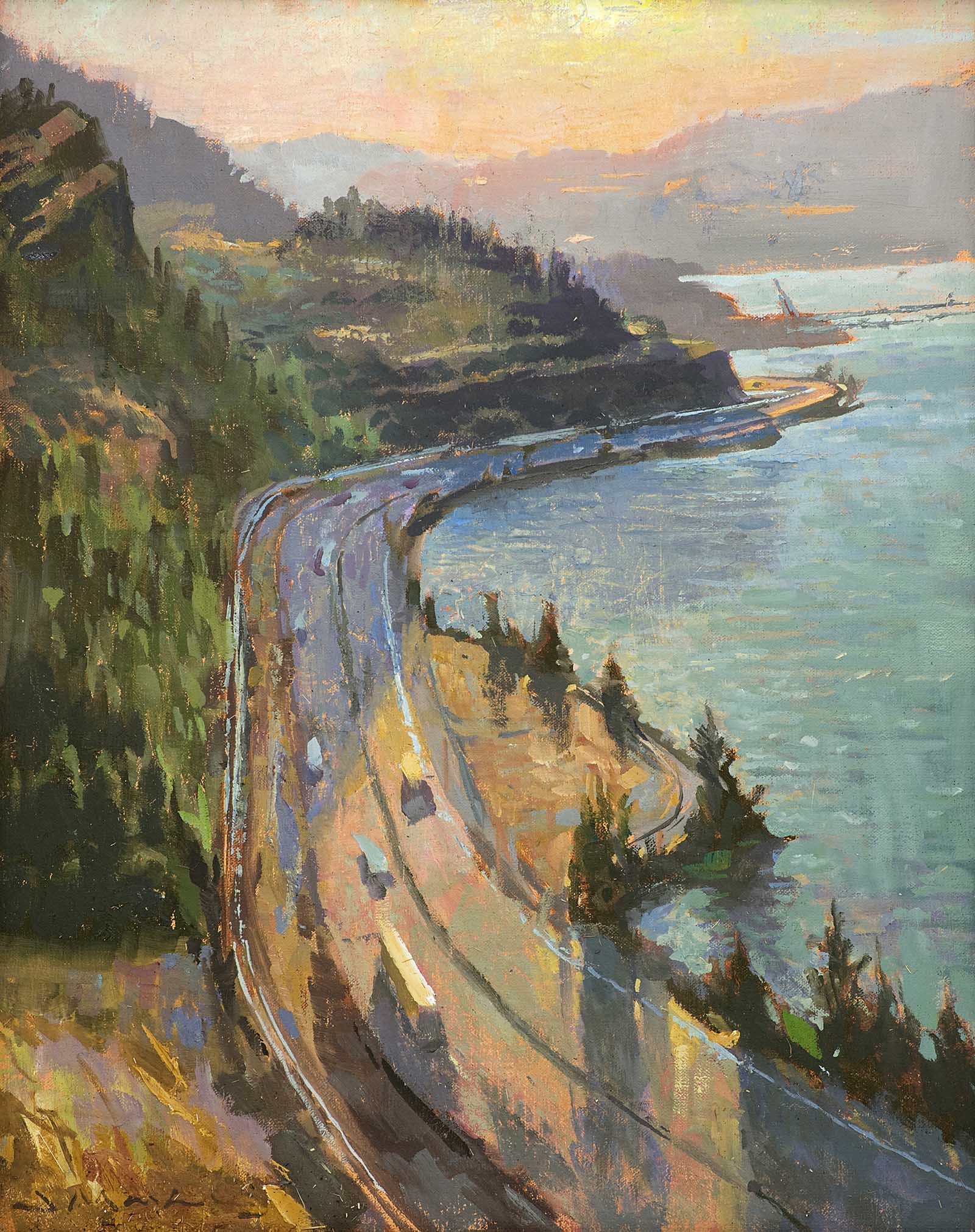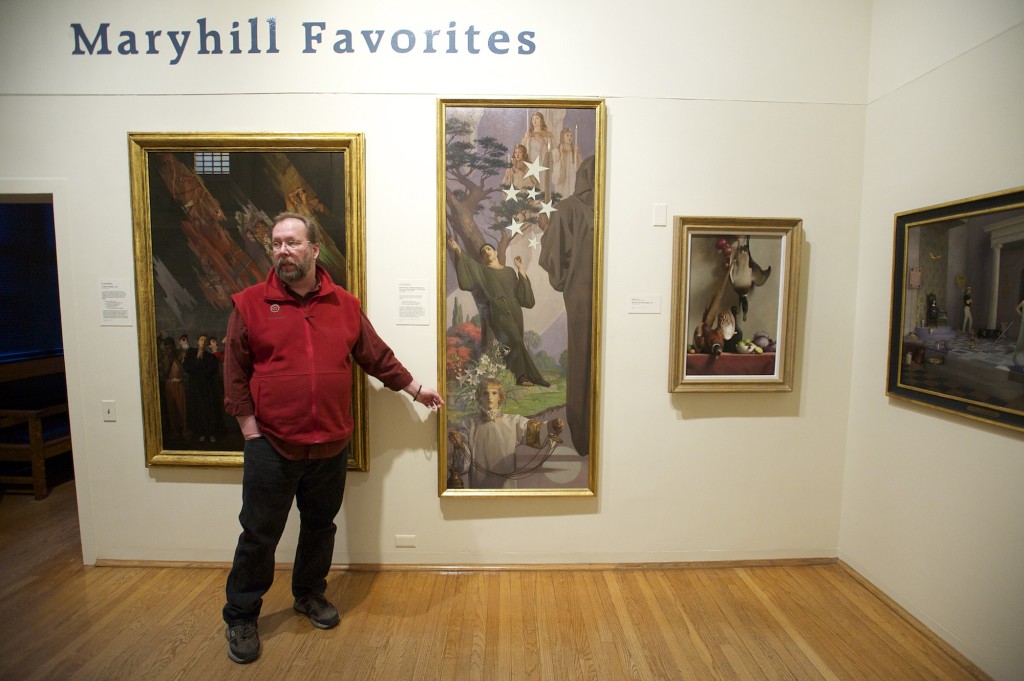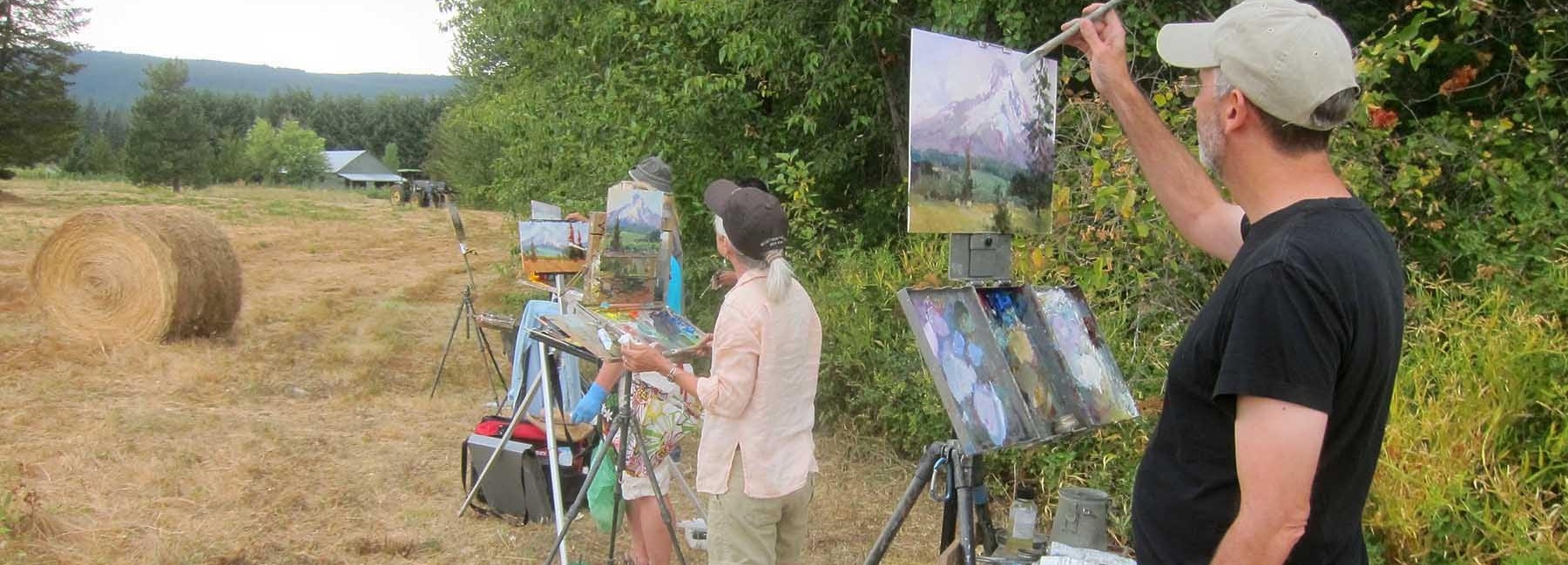 Seeking to deepen and celebrate this connection between art and nature, Hood River artist Cathleen Rehfeld launched in 2006 what has become Pacific Northwest Plein Air in the Columbia River Gorge. This annual "paint-out" and exhibit draws on a long tradition of painting in the open air, attracting some of the finest painters from across the country to capture the Gorge's stunning light and inspiring vistas. After four days of painting, works are displayed at Maryhill with jurors awarding prizes (“Best Sky,” “Best Mountain,” “Best Water" etc.) to the most exceptional works. Since 2016, the event has been hosted by the Maryhill Museum of Art, located on the eastern edge of the Columbia River Gorge National Scenic Area in Goldendale, WA.
Seeking to deepen and celebrate this connection between art and nature, Hood River artist Cathleen Rehfeld launched in 2006 what has become Pacific Northwest Plein Air in the Columbia River Gorge. This annual "paint-out" and exhibit draws on a long tradition of painting in the open air, attracting some of the finest painters from across the country to capture the Gorge's stunning light and inspiring vistas. After four days of painting, works are displayed at Maryhill with jurors awarding prizes (“Best Sky,” “Best Mountain,” “Best Water" etc.) to the most exceptional works. Since 2016, the event has been hosted by the Maryhill Museum of Art, located on the eastern edge of the Columbia River Gorge National Scenic Area in Goldendale, WA.
Earlier this year, staff from Friends and Maryhill met to explore potential partnerships that could further the two organizations' public education and community engagement efforts. As a follow-up from that meeting, Friends and Maryhill developed the idea of a new "Friends of the Columbia Gorge" award to be given to a painting that best illustrates and celebrate the natural beauty and sense of wonder that has served as an inspiration for over 40 years' worth of grassroots community activism, stewardship, and leadership to protect and preserve the Columbia River Gorge for generations to come.
On Saturday, Aug. 3, the public is invited to Maryhill to view the “fresh” paintings artists created in plein air, meet the artists, and enjoy wine and hors d’oeuvres. Awards will be given, including the inaugural Friend of the Columbia Gorge ribbon. Paintings will remain on view and available for purchase at Maryhill Aug. 4-24 in the Event Sales Gallery in the M.J. Murdock Charitable Trust Education Center. Proceeds support Maryhill Museum of Art. As work is sold and removed, other work created during the paint-out will replace it.
We recently spoke with Steve Grafe, curator of art at Maryhill Museum, about the collaboration with Friends, the museum's role in connecting art to Gorge conservation, and the Plein Air event.
How long have you been involved with Maryhill Museum of Art? Where did you work before arriving in the Gorge?
 Steve Grafe: I’ve been Curator of Art at Maryhill Museum for ten years—almost. I started here in September 2009. Prior to that, I was curator of American Indian art at the National Cowboy & Western Heritage Museum in Oklahoma City and chief curator at the Southwest Museum in Los Angeles.
Steve Grafe: I’ve been Curator of Art at Maryhill Museum for ten years—almost. I started here in September 2009. Prior to that, I was curator of American Indian art at the National Cowboy & Western Heritage Museum in Oklahoma City and chief curator at the Southwest Museum in Los Angeles.
As the curator of a museum located at the edge of the Columbia River Gorge National Scenic Area, how would you characterize Maryhill’s relationship to the Gorge itself? How does Plein Air fit into this relationship?
Grafe: Maryhill’s sense of place, its mission, and its public offerings are all tied to the Gorge. The annual Pacific Northwest Plein Air in the Columbia River Gorge paint-out and exhibition are important facets of those. As we continue to acquire work produced during the event, we are also building a valuable collection of contemporary works—created by a diverse group of artists and capturing many different aspects of the Gorge.
In 2011, the museum drafted a collecting plan that outlines priorities for adding to our collection. One area that we’re seeking to enlarge is our holdings of regional landscapes—specifically the Columbia River, Mt. Hood, Mt. Adams, and adjacent areas. We’re also interested in indigenous arts from the same region.
A year or two before I arrived at Maryhill, the museum produced an exhibition about a noted historic Hood River painter, Percy Manser. In 2011-2012, we installed an exhibition, Beside the Big River: Images and Art of the Mid–Columbia Indians, and in 2015, we premiered a display of photos entitled Sam Hill and the Columbia River Highway. That display shows the construction and very early years of the Historic Columbia River Highway, using photos that are mostly drawn from Sam Hill’s own collection.
I’m already working on a 2021 exhibition that is tentatively titled The Columbia River: Wallula to the Sea. That exhibition will contain a number of historic paintings and, as you’d imagine, the Gorge will figure prominently in that. With any luck, we’ll be able to borrow Albert Bierstadt’s painting of Multnomah Falls from the Gilcrease Museum in Tulsa, OK.
What benefits do you see from the collaboration with Friends of the Columbia Gorge?
Grafe: Collaborations between Maryhill and Friends of the Columbia Gorge are natural because so much of what we both do is focused on the Gorge. We both believe that responsible and visionary management of the region is critical to the well-being of local residents and the visitors who travel great distances to take advantage of the region’s many amenities. I see Friends as advocating for the preservation of the natural landscape and managing social responses to it. Much of Maryhill’s efforts focus on preserving historic resources and preserving and promoting aesthetic responses that are grounded in the landscape.
What role do you believe art can play in helping protect and conserve landscapes like the Gorge?
 Grafe: I get excited every time I see copies of the lithographs that were produced to illustrate the Pacific Railroad Surveys of the 1850s. This is partially because they show Columbia River landscapes that predate reservoirs, highways, railroads, and other man-made features. But they’re also appealing because they provide views of places that I know well and with which I have affinities. In a perfect world, every person who ever visits the Gorge would go home with a work of original art that shows a favorite place here. When these works hang in a home, memories are kept alive, emotional connections remain intact, and the desire to return is kept intact. And any number of a person’s friends can ask, “Where’s that?” And in that way the Gorge can make new friends.
Grafe: I get excited every time I see copies of the lithographs that were produced to illustrate the Pacific Railroad Surveys of the 1850s. This is partially because they show Columbia River landscapes that predate reservoirs, highways, railroads, and other man-made features. But they’re also appealing because they provide views of places that I know well and with which I have affinities. In a perfect world, every person who ever visits the Gorge would go home with a work of original art that shows a favorite place here. When these works hang in a home, memories are kept alive, emotional connections remain intact, and the desire to return is kept intact. And any number of a person’s friends can ask, “Where’s that?” And in that way the Gorge can make new friends.
For the layperson, what is “plein air” art?
It’s pretty simple. To paint en plein air essentially means to paint outdoors. There is a sense of immediacy in plein air works because artists must endure heat, cold, or other elements. Smoke was a major player in the 2017 and 2018 paint-outs. Artists also have to deal with changing light, insects, and other factors. I’ve heard some artists refer to plein air painting as a “contact sport.”
Where do the artists who take part in Plein Air come from? Regarding those who hail from outside the region, what areas of the Gorge do they tend to gravitate toward?
The majority of artists who are involved in the Plein Air paint-out and exhibition come from the greater Portland area, Gorge communities, Central Oregon, the Tri-Cities, and western Washington. Several live in the Bay Area and a few live in Southern California. This year, we also have artists coming from Idaho, Arizona, Virginia, and South Carolina.
I’ve never given much thought as to where the artists who travel a great distance decide to paint. They have the option of painting anywhere from Troutdale to the John Day Dam, north to Mt. Adams, and south to Timberline. And that real estate is home to a great many picturesque views.
Art/Photo Credits:
Smoke 'n' 84 - Third Place winner, 2018 Pacific Northwest Plein Air in the Columbia Gorge. Artist: Jeffrey Markowsky, Savannah, GA.
Dr. Steve Grafe at Maryhill Museum of Art. Photo: Steven Lane, the Columbian
Plein air painting in the Columbia Gorge. Photo: Maryhill Museum of Art

